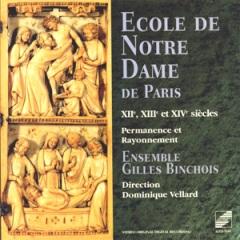Ecole de Notre-Dame de Paris - Permanence et Rayonnement XIIe, XIIIe et XIVe siècles (1993)
Ecole de Notre-Dame de Paris - Permanence et Rayonnement XIIe, XIIIe et XIVe siècles (1993)

1 - Mundus vergens in defectum (4 voices; ms. Florence) - 2 - Angelorum laude digne (2 voices; ms. Las Huelgas) - 3 - Leonin-Perotin: Viderunt omnes ; à 2 (3 voices; ms. Florence) - 4 - Veni creator spiritus (3 voices; ms. Florence) - 5 - Perotin: Dum sigillum summi patris (2 voices; ms. Las Huelgas) - 6 - Eterni numinus mater et filia (2 voices; ms. Las Huelgas) - 7 - Perotin: Sancte Germane (5 voices; ms. Montpelier) - 8 - Perotin: Viderunt omnes ; à 4 (5 voices) - Ensemble Gilles Binchois: Anne-Marie Lablaude - soprano Lena-Susanne Norin - mezzo-soprano Gerd Türk - tenor Dominique Vellard - tenor Hervé Lamy - tenor Emmanuel Bonnardot - baritone Willem de Waal – bass Dominique Vellard – conductor
As has been amply noted by many commentators, the School of Notre-Dame de Paris is one of the most fascinating and fully-achieved artistic phenomena known to Western history. Between 1150 and 1270, a combination of circumstances led to the fruition of a creative current firmly rooted in tradition, and yet so novel it was destined to influence European music everywhere and for all time. The Parisian school’s repertory, and the theoretical treatises analyzing and explaining it, were disseminated throughout countless monasteries and cathedrals in France, England, Spain, Italy, Germany, and German Switzerland. Due both to this wide dissemination and to the interest it aroused among theoreticians, the music from Paris soon constituted a "classic" repertory with a status comparable to that of Gregorian chant.
But even before achieving this broader influence, the music of Notre-Dame already played a significant role in the liturgical life of Paris, due to its more immediate impact on local chapter houses, churches, and monasteries. This is because, contrary to what many have long believed, liturgical polyphony was not sung exclusively within the main choir of the cathedral, but was also performed in the side chapels, the nave, and outside the choir gate as processions halted for a "statio". The choir also often took its music beyond the confines of Notre-Dame itself when participating in the numerous processions, masses, and services celebrated regularly at other churches in Paris, in honor of their respective patron saints.
Tracing the various stages in the physical construction of Notre-Dame cathedral is not our purpose here, but it is worth noting that in 1160, the year construction work on the vast edifice that still commands our admiration today began, new space first needed to be cleared for it. As a result, the crumbling Merovingian Church of St. Stephen was razed, and the nave of the much smaller pre-romanesque Notre-Dame church (known as Notre-Dame II) was temporarily used for services until the choir of the new cathedral (Notre-Dame III) was completed in about 1180. The organa dupla pieces were thus originally composed for, and performed in, the pre-romanesque edifice, before being heard within the walls of the new Gothic structure. The transept and nave were built between 1180 and 1220, and by the time the façade and spires were completed in about 1250, the choir and nave were already being rebuilt in order to let in more light.
It should also be recalled that the choir was surrounded by a wall, built in 1240 and not replaced by a rood screen until the 14th century. Over a span of about one hundred years, starting in 1236, some thirty chapels dedicated to various saints were built around the edges of the nave and choir, and these played a major role in votive mass processions and, hence, in the history of liturgical music.
Pérotin, like all great artists, deployed his considerable talents and virtuosity not only as an innovator, but also as an interpreter of the styles and forms he inherited from his predecessors. In his organa tripla and quadrupla, independent voices are not superimposed rhetorically, but are combined according to pre-established principles of formal composition, musical architectonics and thematic coherence among the different voices. What we see here is the birth of an entirely new melodic and rhythmic archetype, a set of rules constituting the foundation-stone of western melodic equilibrium. In the quadruplum, themes are stated, varied, and developed from one voice to another. Pérotin stands as much more than the mere heir of a musical tradition based largely on the techniques of improvisation. He actually pioneered a wholly new compositional approach exerting broader control over both form and content of the contrapuntal materials.
Surviving today is an 1189 reference to the presence of Magister Petrus Capellanus Episcopi (Master Pierre of the Bishop’s Chapel) employed in the service of Bishop Maurice de Sully. That chapel’s clergy also officiated at services in the episcopal chapel contiguous to the cathedral, and polyphonic music was apparently performed there until at least 1279, since we find the name of a certain Henricus Organista listed among the bishop’s clergy for that period. We learn which pieces should be sung using 2, 3, or 4 voices from two decrees (1198 and 1199) promulgated by Odon de Sully and banning the New Year’s Day Feast of Fools. These documents provide the earliest surviving evidence that the organum was part of the Notre-Dame liturgy (although it had probably been in use long before), and we may justifiably assume that the reference is to Pérotin’s "Viderunt" and "Sederunt" quadrupla.
The number of singers shown in notation for 2, 3, and 4 voice organa dated between 1198 and 1271 varies from two to six, implying soloists rather than a choir. However, the vocal intensity is such, it is reasonable to consider alternation and also, for some sections, the possibility of doubling the tenor voice. ---Dominique Vellard, harmonicclassics.com
download: uploaded yandex 4shared mediafire solidfiles mega filecloudio nornar
Zmieniony (Środa, 19 Luty 2014 15:20)








